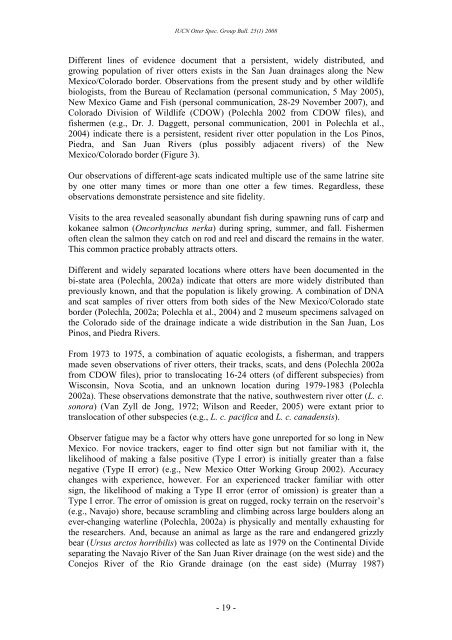N O T E F R O M T H E E D I T O R - Otter Specialist Group
N O T E F R O M T H E E D I T O R - Otter Specialist Group
N O T E F R O M T H E E D I T O R - Otter Specialist Group
- No tags were found...
You also want an ePaper? Increase the reach of your titles
YUMPU automatically turns print PDFs into web optimized ePapers that Google loves.
IUCN <strong>Otter</strong> Spec. <strong>Group</strong> Bull. 25(1) 2008Different lines of evidence document that a persistent, widely distributed, andgrowing population of river otters exists in the San Juan drainages along the NewMexico/Colorado border. Observations from the present study and by other wildlifebiologists, from the Bureau of Reclamation (personal communication, 5 May 2005),New Mexico Game and Fish (personal communication, 28-29 November 2007), andColorado Division of Wildlife (CDOW) (Polechla 2002 from CDOW files), andfishermen (e.g., Dr. J. Daggett, personal communication, 2001 in Polechla et al.,2004) indicate there is a persistent, resident river otter population in the Los Pinos,Piedra, and San Juan Rivers (plus possibly adjacent rivers) of the NewMexico/Colorado border (Figure 3).Our observations of different-age scats indicated multiple use of the same latrine siteby one otter many times or more than one otter a few times. Regardless, theseobservations demonstrate persistence and site fidelity.Visits to the area revealed seasonally abundant fish during spawning runs of carp andkokanee salmon (Oncorhynchus nerka) during spring, summer, and fall. Fishermenoften clean the salmon they catch on rod and reel and discard the remains in the water.This common practice probably attracts otters.Different and widely separated locations where otters have been documented in thebi-state area (Polechla, 2002a) indicate that otters are more widely distributed thanpreviously known, and that the population is likely growing. A combination of DNAand scat samples of river otters from both sides of the New Mexico/Colorado stateborder (Polechla, 2002a; Polechla et al., 2004) and 2 museum specimens salvaged onthe Colorado side of the drainage indicate a wide distribution in the San Juan, LosPinos, and Piedra Rivers.From 1973 to 1975, a combination of aquatic ecologists, a fisherman, and trappersmade seven observations of river otters, their tracks, scats, and dens (Polechla 2002afrom CDOW files), prior to translocating 16-24 otters (of different subspecies) fromWisconsin, Nova Scotia, and an unknown location during 1979-1983 (Polechla2002a). These observations demonstrate that the native, southwestern river otter (L. c.sonora) (Van Zyll de Jong, 1972; Wilson and Reeder, 2005) were extant prior totranslocation of other subspecies (e.g., L. c. pacifica and L. c. canadensis).Observer fatigue may be a factor why otters have gone unreported for so long in NewMexico. For novice trackers, eager to find otter sign but not familiar with it, thelikelihood of making a false positive (Type I error) is initially greater than a falsenegative (Type II error) (e.g., New Mexico <strong>Otter</strong> Working <strong>Group</strong> 2002). Accuracychanges with experience, however. For an experienced tracker familiar with ottersign, the likelihood of making a Type II error (error of omission) is greater than aType I error. The error of omission is great on rugged, rocky terrain on the reservoir’s(e.g., Navajo) shore, because scrambling and climbing across large boulders along anever-changing waterline (Polechla, 2002a) is physically and mentally exhausting forthe researchers. And, because an animal as large as the rare and endangered grizzlybear (Ursus arctos horribilis) was collected as late as 1979 on the Continental Divideseparating the Navajo River of the San Juan River drainage (on the west side) and theConejos River of the Rio Grande drainage (on the east side) (Murray 1987)- 19 -
















